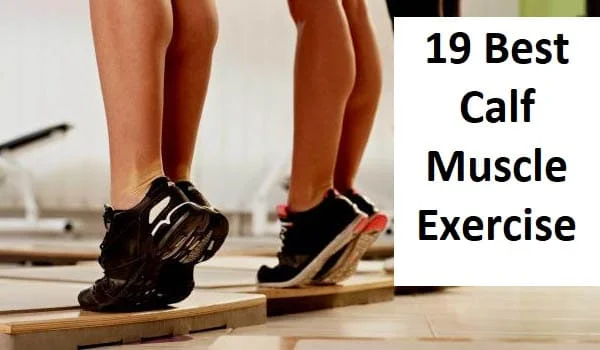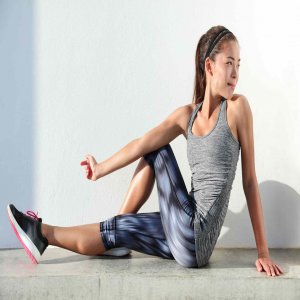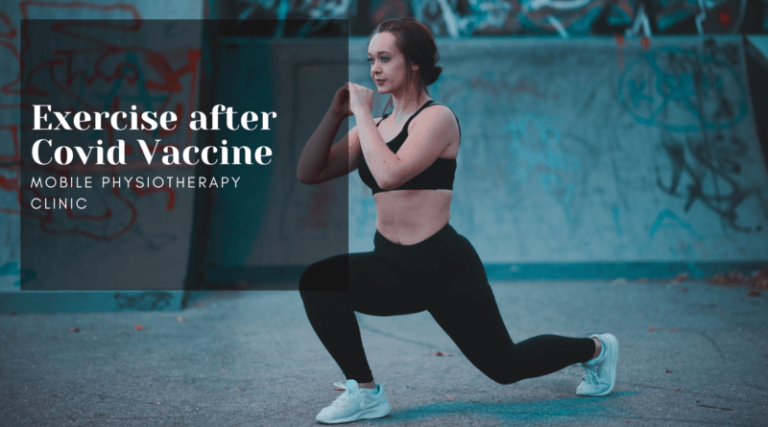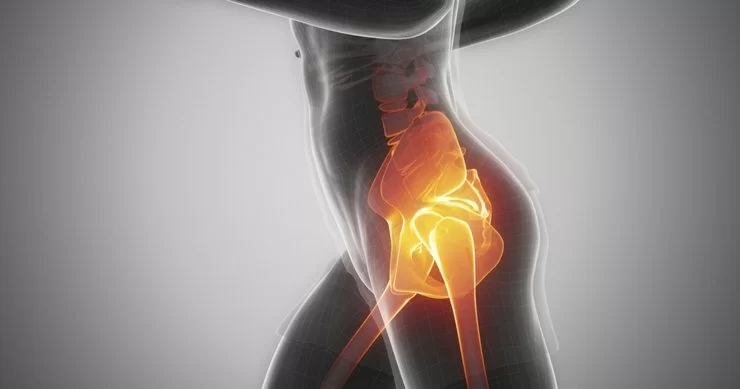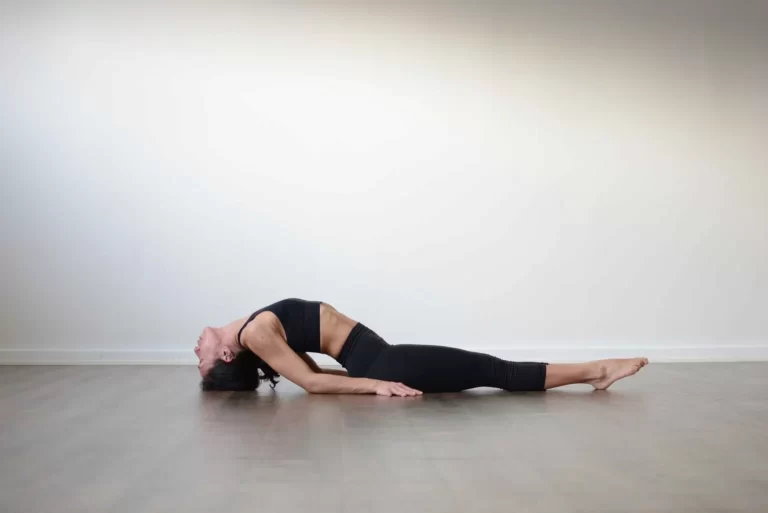19 Best Calf Muscle Exercise
Calf muscles play a crucial role in providing stability, balance, and power to our lower limbs. Whether you’re an athlete aiming to enhance your performance or simply looking to improve your overall lower body strength, incorporating calf muscle exercises into your fitness routine is essential.
These exercises specifically target the gastrocnemius and soleus muscles, which make up the calf complex. In this guide, we will explore a variety of effective calf muscle exercises that can help you build strength, prevent injuries, and achieve a well-rounded lower-body fitness level.
From classic exercises like calf raises to more advanced variations, this guide will provide you with the knowledge to sculpt strong and resilient calf muscles. So, let’s dive into the world of calf muscle exercises and take a step towards a stronger foundation for your active lifestyle.
What is calf muscle?
The calf muscles are a group of muscles located in the back of the lower leg, specifically between the knee and ankle joint. The calf muscles are responsible for plantar flexion (pointing the foot downwards) and dorsiflexion (lifting the foot upwards). The main calf muscles are the gastrocnemius, soleus, and plantaris.
The gastrocnemius is the largest and most visible muscle of the calf. It is a two-headed muscle that originates from the femur bone and inserts into the Achilles tendon. The gastrocnemius muscle is responsible for plantar flexion and knee flexion. It is also involved in jumping and running activities.
Soleus:
The soleus muscle is situated beneath the gastrocnemius muscle. It originates from the tibia and fibula bones and inserts into the Achilles tendon. The soleus muscle is responsible for plantar flexion and is more active during standing and walking activities.
Plantaris:
The plantaris muscle is a small, thin muscle located behind the gastrocnemius muscle. It originates from the femur bone and is inserted into the Achilles tendon. The plantaris muscle is also involved in plantar flexion.
The calf muscles receive their blood supply from the posterior tibial artery and are innervated by the tibial nerve. The calf muscles are important for maintaining balance, stability, and mobility in the lower leg. They are also prone to injury, particularly strains or tears due to overuse or sudden movements. Proper stretching and strengthening exercises can help prevent calf muscle injuries.
Strengthening Exercise of a Calf Muscle
Single-Leg Heel Raise
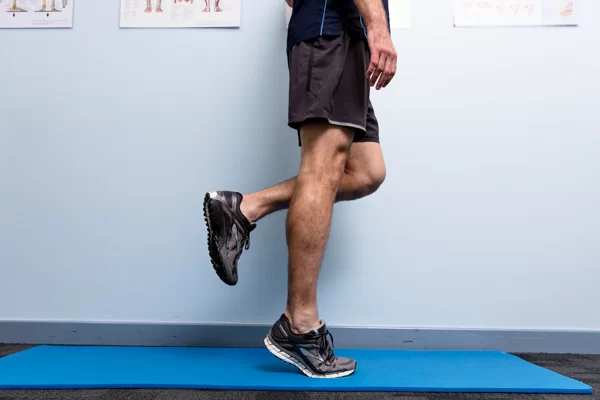
The Single-Leg Heel Raise is a lower-body exercise that targets the calves, specifically the gastrocnemius and soleus muscles. It is a bodyweight exercise that can be done anywhere and requires no equipment.
To perform the Single-Leg Heel Raise, follow these steps:
- Stand on one leg with your other leg lifted a little bit off the surface.
- Place your hands on a wall or sturdy object for balance if needed.
- Slowly raise your heel off the ground, lifting up onto the ball of your foot.
- Pause at the top of the movement, then slowly lower your heel back down to the ground.
- Do it again for the desired number of repetitions, then change legs and repeat.
Points to take in mind during exercise:
Maintain your core engaged and your posture tall throughout the whole exercise.
Focus on squeezing your calf muscles as you lift your heel.
To make the exercise more challenging, try holding a weight in one hand or using a resistance band around your ankles.
If you have any knee or ankle issues, consult with a healthcare professional before attempting this exercise.
Double-Leg Heel Raise
What it does: Builds concentric calf strength (only needed if you cannot do ten or more single-leg heel raises with a full range of motion).
The Double-Leg Heel Raise is a lower body exercise that targets the calves, specifically the gastrocnemius and soleus muscles. It is a bodyweight exercise that can be done anywhere and requires no equipment.
To perform the Double-Leg Heel Raise, follow these steps:

- Stand with your feet shoulder-width away and your toes pointing forward.
- Place your hands on a wall or sturdy object for balance if needed.
- Slowly raise both heels off the ground, lifting up onto the balls of your feet.
- Pause at the top of the movement, then slowly lower your heels back down to the ground.
- Repeat for at least 15 to 20 repetitions.
Points to take in mind during exercise:
Maintain your core engaged and your posture tall throughout the whole exercise.
Focus on squeezing your calf muscles as you raise your heels.
To make the exercise more challenging, try holding a weight in each hand or using a resistance band around your ankles.
If you have any knee or ankle issues, consult with a healthcare professional before attempting this exercise.
The Seated Calf Raise
The Seated Calf Raise is a lower-body exercise that targets the calves, specifically the soleus muscle. It is a weight-bearing exercise that requires a calf-raise machine or a bench and a set of dumbbells.
To perform the Seated Calf Raise, follow these steps:

- Sit on a calf raise machine or on a bench with a set of dumbbells on your thighs.
- Place the balls of your feet on the footrest or on a step with your heels hanging off the edge.
- Adjust the height of the footrest or step so that your knees are bent at a 90-degree angle.
- Grasp the handles of the machine or the sides of the bench for support.
- Gradually raise your heels as high as possible you can, squeezing your calf muscles at the top of the motion.
- Pause at the top of the movement, then slowly lower your heels back down to the starting position.
- Repeat for the desired number of repetitions.
Points to take in mind during exercise:
Maintain your core engaged and your posture tall during the exercise.
Focus on squeezing your calf muscles as you raise your heels.
To make the exercise more challenging, increase the weight or use a single leg at a time.
If you have any knee or ankle issues, consult with a healthcare professional before attempting this exercise.
The Bosu Calf Raise
The Bosu Calf Raise is a variation of the Seated Calf Raise that adds an element of instability to the exercise, challenging your balance and engaging more muscles in your lower body. To perform the Bosu Calf Raise, follow these steps:
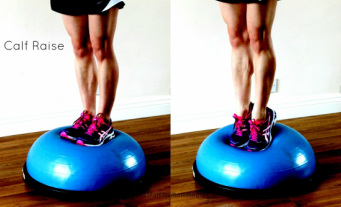
- Put a Bosu ball on the floor with the flat side upward.
- Stand on the Bosu ball with the balls of your feet, keeping your heels off the ground.
- Engage your core muscles and maintain your posture tall.
- Gradually raise your heels as high as you can, squeezing your calf muscles at the top of the motion.
- Pause at the top of the movement, then slowly lower your heels back down to the starting position.
- Do it again for the desired number of repetitions.
Points to take in mind during exercise:
Keep your balance by focusing on a fixed point in front of you.
Start with a lower number of repetitions and gradually increase as you build strength and stability of calf muscle.
To make the exercise more challenging, hold a set of dumbbells or add a single-leg variation.
If you have any balance or stability issues, consult with a healthcare professional before attempting this exercise.
wing these steps, you can perform the exercise safely and effectively to achieve your fitness goals.
The wall seat calf raise
The wall seat calf raise is a simple yet effective exercise that targets the calf muscles. Here is a detailed explanation of how to perform this exercise:
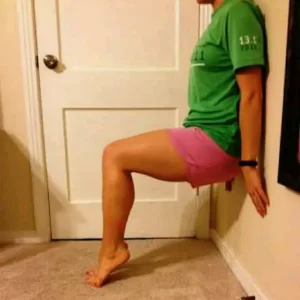
- Get a wall or sturdy surface to lean against. Make sure you stand facing the wall with your feet hip-width apart.
- Lean against the wall and slide down until your knees are bent at a 90-degree angle. Your thighs should be parallel to the surface, and your knees should be directly over your ankles.
- Place your hands on your hips or hold onto the wall for balance.
- Lift your heels off the surface and rise up onto the balls of your feet. Hold this position for a few seconds, squeezing your calf muscles.
- Gradually lower your heels back down to the surface.
- Repeat for the desired number of repetitions, aiming for 15-20 reps per set.
- Take a short rest period between sets before starting the next batch.
Points to take in mind during exercise:
maintain your back straight and your core engaged throughout the exercise.
Make sure your knees stay directly above your ankles and do not move forward or backward.
Focus on lifting and lowering your heels slowly and with control.
Squeeze your calf muscles at the top of the movement for maximum contraction.
If you find this exercise too easy, you can hold onto dumbbells or other weights to increase the resistance.
Overall, the wall seat calf raise is a great exercise for strengthening and toning the calf muscles. It can be done anywhere with a wall or sturdy surface and requires no equipment, making it a convenient addition to any workout routine.
Body weight calf raising
Body weight calf raising is a simple yet effective exercise that can be done anywhere without any equipment. Here are the steps to perform bodyweight calf raising:
- Stand with your feet hip-width away and your toes pointing forward.
- Gradually lift your heels off the surface, rising up onto the balls of your feet.
- Hold the position for a few seconds, then lower your heels back down to the ground.
- Repeat the movement for several repetitions, aiming for 10-15 reps per set.
- To increase the difficulty of the exercise, you can perform the calf raises on a step or other elevated surface, allowing your heels to drop below the level of your toes before rising up onto the balls of your feet.
- To target different areas of the calf muscles, you can also vary the position of your toes, rotating them inward or outward as you perform the calf raises.
Body weight calf raising is a great exercise for building strength and endurance in the calf muscles, as well as improving balance and stability in the lower legs. It can be easily incorporated into any workout routine and can be modified to suit individual fitness levels and goals.
Standing Dumbbell or Barbell Calf Raise
Standing Dumbbell or Barbell Calf Raise is an exercise that targets the muscles of the calves, specifically the gastrocnemius and soleus muscles. It involves standing with your feet shoulder-width apart while holding a dumbbell or barbell on your shoulders or in your hands, then lifting your heels off the ground as high as possible and lowering them back downward.
Here are the steps to perform Standing Dumbbell or Barbell Calf Raise:
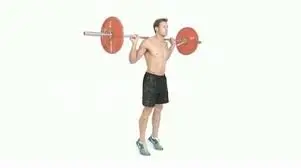
- Stand with your feet shoulder-width apart and hold a dumbbell or barbell on your shoulders or in your hands.
- Maintain your back straight and your core muscles engaged.
- Lift your heels off the ground as high as possible while keeping your toes on the floor.
- Hold the position for a second or two, then slowly lower your heels back down to the ground.
- Do it again for the desired number of repetitions.
Points to take in mind during exercise:
Make sure to keep your knees straight during the exercise.
Focus on contracting your calf muscles as you lift your heels off the ground.
You can vary the width of your stance and the position of your toes to target different areas of your calves.
If using a barbell, make sure to keep it balanced on your shoulders to avoid injury.
Barbell Split Squats
Barbell Split Squats are a compound exercise that targets multiple muscle groups, including the quadriceps, glutes, hamstrings, and calves. It involves standing with one foot forward and the other foot back while holding a barbell on your shoulders, then lowering your back knee towards the ground while keeping your front knee bent.
Here are the steps to perform Barbell Split Squats:
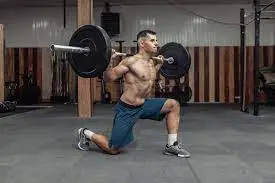
- Start by standing with your feet shoulder-width apart and holding a barbell on your shoulders.
- Take a step forward with one foot and a step back with the other foot, making sure to keep your feet hip-width apart.
- Maintain your torso upright and your core engaged throughout the exercise.
- Lower your back knee towards the ground while keeping your front knee bent, making sure to keep your front knee in line with your toes.
- Stop when your back knee is just above the ground, then push through your front foot to return to the starting position.
- Do it again for the desired number of repetitions, then switch legs and repeat.
Points to take in mind during exercise:
Make sure to keep your front knee in line with your toes to avoid injury.
Maintain your torso upright during the exercise to engage your core and maintain proper form.
You can vary the width of your stance to target different areas of your legs.
Initiate with a lighter weight to ensure proper form before raising the weight.
Leg press exercise
The leg press is a popular exercise that focuses on the lower body muscles, involving the quadriceps, hamstrings, and glutes. It involves pushing a weight sled away from your body using your legs while seated on a machine.
Here are the steps to perform the leg press exercise:
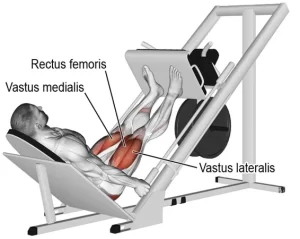
- Start by adjusting the seat and footplate of the leg press machine to fit your body size. Sit on the machine with your back pressed against the backrest and your feet on the footplate.
- Put your feet shoulder-width away on the footplate, with your toes pointing a little bit outward.
- Release the safety locks and push the weight sled away from your body by extending your legs.
- Lower the weight sled towards your body by bending your knees, making sure to keep your back flat against the backrest.
- Stop when your knees are at a 90-degree angle, then push the weight sled away from your body again to complete one rep.
- Do it again for a few repetitions.
Points to take in mind during exercise:
Make sure to keep your back flat against the backrest throughout the exercise to avoid injury.
Keep your knees in line with your toes to avoid putting unnecessary strain on your knees.
Arrange the weight according to your fitness level and goals.
Vary your foot placement on the footplate to target different areas of your legs.
Jumping Calf Press
The jumping calf press is an exercise that targets the calf muscles, specifically the gastrocnemius and soleus muscles. It involves jumping up from a standing position while simultaneously performing a calf raise.
Here are the steps to perform the jumping calf press exercise:
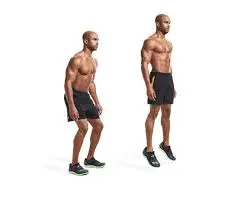
- Start by standing with your feet shoulder-width away and your toes pointing forward.
- Bend your knees slightly and lift your heels off the ground, coming up onto the balls of your feet.
- From this position, jump up explosively, pushing off the balls of your feet and extending your legs fully.
- While in mid-air, perform a calf raise by flexing your feet and lifting your heels as high as you can.
- Land softly on the balls of your feet and immediately lower your heels back down to the ground.
- Do it again for the desired number of repetitions.
Points to take in mind during exercise:
Make sure to land softly to avoid any impact on your joints.
Maintain your core engaged during the exercise to maintain stability.
Start with small jumps and gradually increase the height of your jumps as you become more comfortable with the exercise.
Arrange the number of repetitions and sets according to your fitness level and goals.
Carioca Agility Ladder Drill
The Carioca Agility Ladder Drill is a dynamic exercise that improves agility, coordination, and footwork. It involves moving laterally through an agility ladder while crossing your feet over and under each rung.
Here are the steps to perform the Carioca Agility Ladder Drill:
- Begin by standing next to the agility ladder with your left side facing the ladder and your feet shoulder-width apart.
- Step into the first square of the ladder with your left foot, crossing it over your right foot.
- Step your right foot to the right of the ladder, outside of the first square.
- Step your left foot into the second square of the ladder, crossing it under your right foot.
- Step your right foot to the right of the ladder, outside of the second square.
- Repeat this pattern, crossing over and under each rung of the ladder as you move laterally down the length of the ladder.
- When you reach the end of the ladder, reverse direction and move back down the ladder with the opposite foot leading.
- Continue moving back and forth through the ladder for the desired number of reps or times.
Points to take in mind during exercise:
Keep your knees slightly bent during the exercise to maintain balance and stability.
Maintain your core engaged to help control your movements.
Start with a slow and controlled pace and gradually increase your speed as you become more comfortable with the exercise.
Focus on keeping your feet light and quick as you move through the ladder.
Jumping rope
Jumping rope is a simple and effective exercise that targets the calf muscles. It involves repeatedly jumping over a rope while keeping your feet together and your calves engaged.
Here are the steps to perform jumping rope for the calf:

- Begin by selecting an appropriate jump rope. The rope should be long enough to reach your armpits when you stand in the center of it with your feet together.
- Stand with your feet together and hold the handles of the jump rope in each hand, with the rope behind you.
- Swing the rope over your head and jump over it as it comes down in front of you.
- Land on the balls of your feet, keeping your knees slightly bent and your calves engaged.
- Continue jumping over the rope, keeping your feet together and your calves engaged throughout the exercise.
- Start with a slow and controlled pace, and gradually increase your speed as you become more comfortable with the exercise.
- Aim to perform 3 sets of 30-60 seconds of jumping rope for calf, with a 30-second rest between each set.
Points to take in mind during exercise:
Maintain your core engaged during the whole exercise to maintain balance and stability.
Keep your shoulders relaxed and your arms close to your body as you jump.
Focus on landing softly on the balls of your feet to reduce impact on your joints.
If you are new to jumping rope, start with shorter sets and gradually increase the duration as you build up strength and endurance.
Calf stretching Exercises
Standing calf stretching

The standing calf stretch is a simple yet effective stretch that targets the calf muscles.
To do a calf stretch, start with a standing position facing a wall with your hands on the wall at the level of shoulder height. Step one foot back, keeping both feet facing forward and your heels on the ground. Your back leg should be straight with your knee locked out.
Next, lean forward into the wall, keeping your back leg straight and your heel on the ground. You should experience a stretch in your calf muscle. Hold this position for 10-30 seconds as per your stamina, then switch to opposite sides and repeat.
It’s important to keep your back leg straight and your heel on the ground to properly stretch the calf muscle. If you have trouble keeping your heel on the ground, try moving your foot slightly closer to the wall or using a lower surface to place your hands on.
The standing calf stretch can be done as part of a warm-up before exercise or as a cool-down after exercise. It can also be done throughout the day to help improve flexibility and prevent injury.
Towel stretching
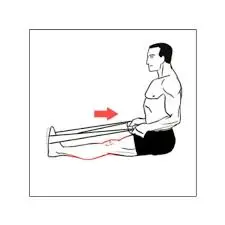
The towel stretch is another effective stretch that targets the calf muscles. To perform this stretch, you will need a towel or a resistance band.
Initiate by sitting on the ground with your legs straight out in front of you. Place the towel or resistance band around the ball of one foot. take a grip onto each end of the towel with your hands.
Next, gently pull the towel towards you while keeping your leg straight. You should experience a stretch in your calf muscle. Hold this position for 10-30 seconds as per your stamina, then switch to opposite sides and repeat.
It’s important to keep your leg straight and not to pull too hard on the towel to avoid injury. If you have trouble keeping your leg straight, try bending your knee slightly or using a longer towel.
The towel stretch can also be done as part of a warm-up before exercise or as a cool-down after exercise. It can help improve flexibility and prevent injury in the calf muscle.
Heel drop stretch
Heel drop stretch is a type of stretching exercise that targets the muscles of the calf and Achilles tendon. It involves dropping the heel of one foot below the level of a raised surface, such as a step or curb. This movement stretches the muscles on the back of the leg and foot, including the gastrocnemius and soleus muscles, as well as the Achilles tendon.
To perform a heel drop stretch, follow these steps:
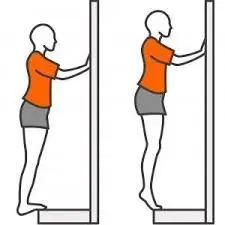
- Find a raised surface, such as a step or curb, that is stable and secure.
- Stand on the edge of the raised surface with the balls of your feet on the edge and your heels hanging off.
- Slowly lower one heel towards the ground, keeping your knee straight.
- Hold this position for 15-30 seconds, feeling a stretch in your calf muscles and Achilles tendon.
- Lift your heel back up to the starting position and relax for a few seconds.
- Repeat the stretch for 2-3 sets, gradually increasing the duration of each stretch.
There are several variations of the heel drop stretch that can be performed to target different muscles in the lower leg. For example, to stretch the soleus muscle, which runs along the back of the lower leg, you can perform a heel drop stretch with your knee bent.
It is very necessary to perform heel drop stretches safely and gradually, especially if you have a history of ankle or foot injuries. Avoid overstretching or bouncing during the stretch, and stop if you feel any pain or discomfort. As with any stretching exercise, it is best to take the guidance of a healthcare professional before starting a new stretching routine.
The lunging calf stretch
The lunging calf stretch is a stretching exercise that targets the muscles of the calf and Achilles tendon. It involves stepping forward with one foot while keeping the other foot planted behind, then bending the front knee to stretch the back leg.
To perform a lunging calf stretch, follow these steps:
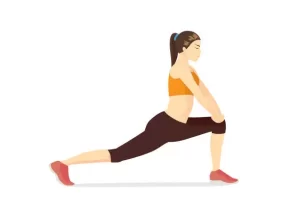
- Stand with your feet nearby hip-width wide and take a large stride forward with one foot.
- Keep your back foot planted on the ground and ensure that both feet are facing forward.
- Bend your front knee and lean forward slightly, keeping your back leg straight.
- Press your back heel into the ground and feel a stretch in your calf muscle and Achilles tendon.
- Hold this position for 15-30 seconds, then release and switch legs.
- Repeat the stretch for 2-3 sets, gradually increasing the duration of each stretch.
There are several variations of the lunging calf stretch that can be performed to target different muscles in the lower leg. For example, to stretch the soleus muscle, which runs along the back of the lower leg, you can perform a lunge with your back knee bent.
Standing Bent-Over Calf Stretch
The Standing Bent-Over Calf Stretch is a stretching exercise that targets the muscles of the calf and Achilles tendon. It involves standing with your feet hip-width apart, then bending forward at the waist to stretch the back of your legs.
To perform a Standing Bent-Over Calf Stretch, follow these steps:
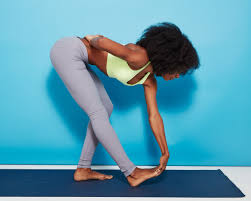
- Stand with your feet hip-width away and put your hands on your hips.
- Take a step back with one foot and place it about two feet behind the other foot.
- Keep both feet facing forward and ensure that your back foot is flat on the ground.
- Gradually bend forward at the waist, maintaining your back straight and your head up.
- Reach towards your toes with your hands and feel a stretch in your calf muscle and Achilles tendon.
- Hold this position for 15-30 seconds, then release and switch legs.
- Repeat the stretch for 2-3 sets, gradually increasing the duration of each stretch.
There are several variations of the Standing Bent-Over Calf Stretch that can be performed to target different muscles in the lower leg. For example, to stretch the soleus muscle, which runs along the back of the lower leg, you can perform the stretch with your back knee bent.
Seated Calf Stretch
The Seated Calf Stretch is a simple yet effective stretch that targets the calf muscles. It can be performed anywhere, anytime, and does not need any equipment. Here is a step-by-step guide on how to perform the Seated Calf Stretch:
- You have to Sit on the ground and your legs should be extended in front of you.
- Cross one leg over the other, placing the ankle of the crossed leg on top of the knee of the other leg.
- Place your hands on the top of the foot of the crossed leg and gently press down towards your body.
- You should experience a stretch in your calf muscle. Hold this stretch for 15-30 seconds.
- Release the stretch and do it again on the other side.
- For a deeper stretch, you can use a towel or resistance band to pull your foot towards your body.
- Take in mind to breathe deeply during the stretch and avoid bouncing or jerking motions.
The Seated Calf Stretch can help improve flexibility, reduce muscle tension, and prevent injury. It is particularly beneficial for athletes who engage in activities that require a lot of jumping or running. Incorporate this stretch into your daily routine to maintain healthy and flexible calf muscles.
Isometric calf stretch
The Isometric Calf Raise is an exercise that targets the calf muscles and can be done without any equipment. It involves holding a static position rather than performing a full range of motion. Here is a step-by-step guide on how to perform the Isometric Calf Raise:
- Stand with your feet shoulder-width away and your hands should be on your hips or at your sides.
- Lift your heels off the ground and hold this position for 10-30 seconds.
- You should experience a contraction in your calf muscles. maintain your core engaged and maintain good posture during the exercise.
- Slowly lower your heels back down to the ground and rest for a few seconds.
- Repeat the exercise for 3-5 sets, with a 30-60 second rest between each set.
- To make the exercise more challenging, you can perform it on one leg at a time or hold a weight in each hand.
The Isometric Calf Raise is a great exercise for building strength and endurance in the calf muscles. It can also help in improving balance and stability. Incorporate this exercise into your workout routine to strengthen your calves and prevent injury.
Benefits of the exercise
Calf muscle exercises can provide numerous benefits for individuals of all ages and fitness levels. Here are some of the key benefits of calf muscle exercises:
- Improved Strength: Calf muscle exercises can help improve the strength and endurance of the calf muscles, which can lead to better overall leg strength and stability. This can be particularly beneficial for athletes who need strong and stable legs for running, jumping, and other activities.
- Increased Flexibility: Calf muscle exercises can also help improve flexibility in the lower leg, which can lead to a better range of motion and reduced risk of injury. Tight calf muscles can contribute to a variety of lower leg injuries, including strains, sprains, and plantar fasciitis.
- Better Balance and Stability: Strong and flexible calf muscles can also help improve balance and stability, which can be beneficial for individuals of all ages. This can be particularly important for older adults who may be at risk for falls and other balance-related injuries.
- Reduced Pain and Discomfort: Calf muscle exercises can also help reduce pain and discomfort in the lower leg, particularly for individuals who spend a lot of time on their feet or who have existing lower leg injuries. Strengthening and stretching the calf muscles can help alleviate pain and discomfort in the feet, ankles, and lower legs.
- Improved Athletic Performance: Finally, calf muscle exercises can help improve athletic performance by increasing strength, flexibility, balance, and stability. This can lead to better running speed, jumping ability, and overall athletic performance.
Contraindications of the exercise
There are certain contraindications or situations where performing calf muscle exercises, including jumping rope for the calf, may not be recommended. These include:
- Injury or pain in the calf muscles: If you have an injury or pain in your calf muscles, it is important to rest and allow them to heal before performing any exercises that may aggravate the condition.
- Joint problems: If you have joint problems such as arthritis or osteoporosis, jumping rope for calf may put too much stress on your joints and worsen your condition.
- Cardiovascular conditions: If you have a cardiovascular condition such as heart disease or high blood pressure, it is important to consult with your doctor before performing any high-intensity exercises such as jumping rope.
- Pregnancy: Pregnant women should avoid jumping rope for calf as it may increase the risk of falls and injury.
- Overuse injuries: If you perform jumping rope for the calf too frequently or without proper form, you may develop overuse injuries such as shin splints or Achilles tendonitis.
It is very necessary to listen to your body and consult with a healthcare professional before starting any new exercise routine, especially if you have any underlying health conditions or concerns.
FAQ
Can bodyweight calf raises be done with weights?
Yes, you can add weights to your body weight and calf raises for added resistance and challenge.
How long should I hold the contraction at the top of the calf raise?
Hold the contraction at the top of the calf and raise for 1-2 seconds before lowering back down.
Are there any modifications for body weight calf raises for beginners?
Yes, beginners can start with a smaller range of motion and fewer reps, or perform the exercise while seated or holding onto a sturdy object for support.
What other exercises can I do to strengthen my calves?
Other exercises that can strengthen your calves include jump rope, stair climbing, and standing heel raises with weights.
How long does it take to see results from body weight calf raises?
Results can vary, but with consistent practice and proper nutrition, you may start to see results in as little as 4-6 weeks.

